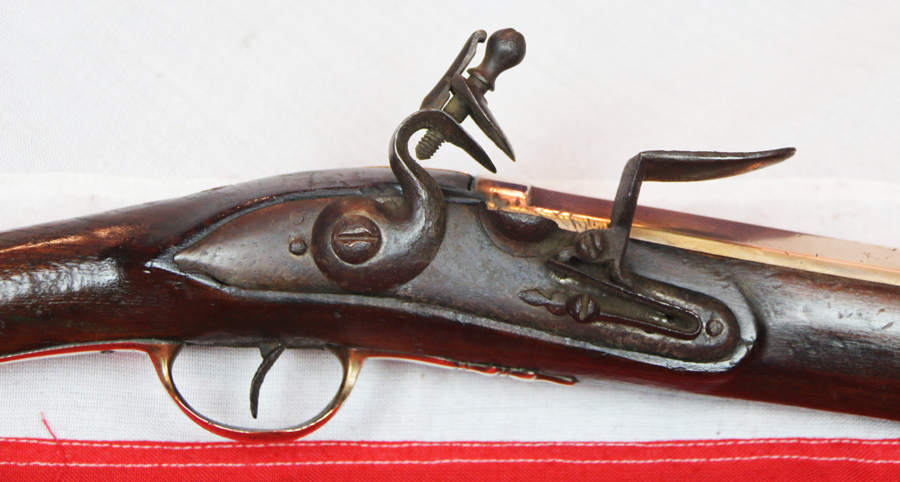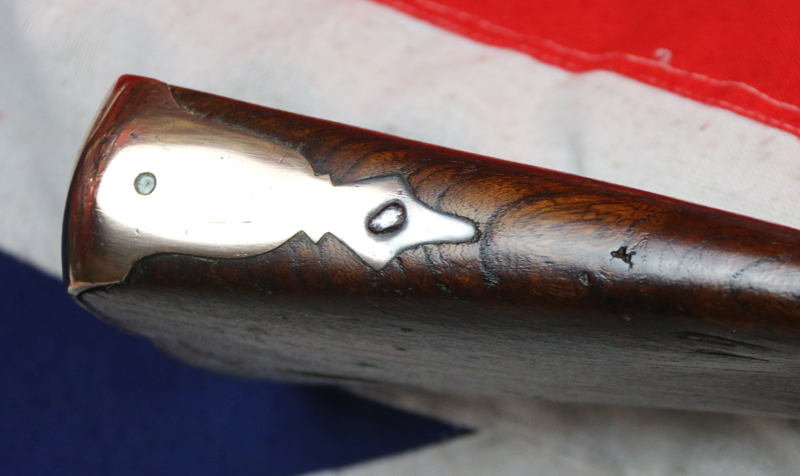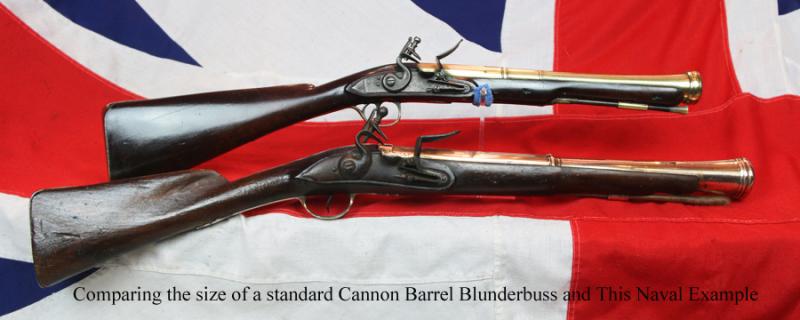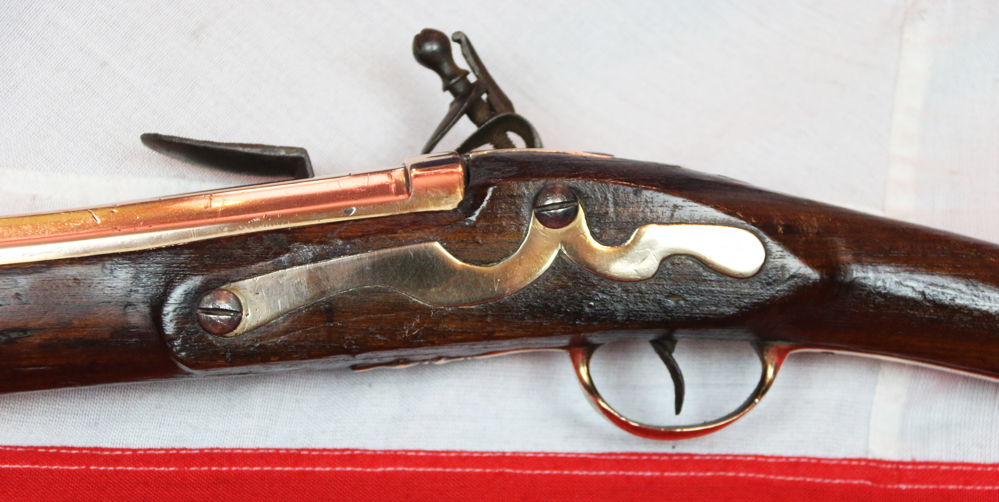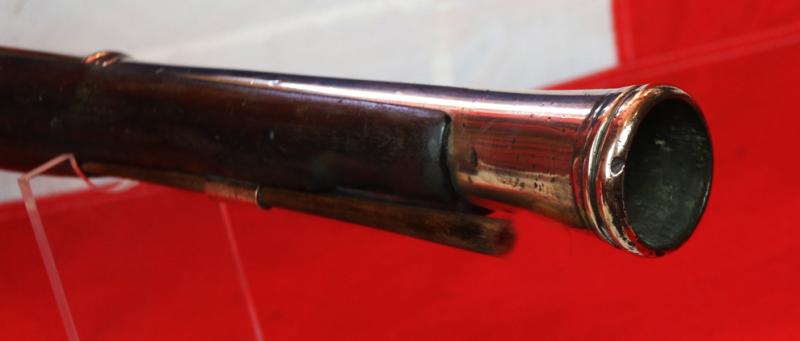A Fabulous, Incredibly Impressive, Historical & Very Rare Large 1754 American Anglo-French-Indian War & Revolutionary War of 1776 Period Flintlock Sea Service Bronze Cannon Barrel Blunderbuss. A Stunning Work Of Art As Much As A Huge Sea Service Flintlock
Blunderbuss that survive from this earliest era are so incredibly rare. An amazingly beautiful sea service flintlock that was made and saw service during the era of the American theatre of conflict of the Anglo-French-Indian war {1754-1763}, the era as wonderfully depicted in the classic historical novel, of the Anglo-French-Indian War in the Americas in the late 1750's 'Last of the Mohican's' by James Fenimore Cooper, featuring the Mohican Chingachgook, and his white adopted son 'Hawkeye'.
The British colonists were supported at various times by the Iroquois, Catawba, and Cherokee tribes, and the French colonists were supported by Wabanaki Confederacy members Abenaki and Mi'kmaq, and the Algonquin, Lenape, Ojibwa, Ottawa, Shawnee, and Wyandot (Huron). Fighting took place primarily along the frontiers between New France and the British colonies, from the Province of Virginia in the south to Newfoundland in the north. It began with a dispute over control of the confluence of the Allegheny River and Monongahela River called the Forks of the Ohio, and the site of the French Fort Duquesne at the location that later became Pittsburgh, Pennsylvania. The dispute erupted into violence in the Battle of Jumonville Glen in May 1754, during which Virginia militiamen under the command of 22-year-old George Washington ambushed a French patrol. The British sent out their fleet in February 1755, intending to blockade French ports, but the French fleet had already sailed. Admiral Edward Hawke detached a fast squadron to North America in an attempt to intercept them.
In June 1755, the British captured French naval ships sent to provide war matériel to the Acadian and Mi'kmaw militias in Nova Scotia.
In a second British action, Admiral Edward Boscawen fired on the French ship Alcide on June 8, 1755, capturing her and two troop ships. The British harassed French shipping throughout 1755, seizing ships and capturing seamen. These actions contributed to the eventual formal declarations of war in spring 1756.
This blunderbuss may have potentially seen service, amongst other conflicts, at the Battle of Restigouche. It was a naval battle fought in 1760 during the French and Indian War on the Restigouche River between the British Royal Navy and the small flotilla of vessels of the French Navy, Acadian militia and Mi'kmaq militias. The loss of the French vessels, which had been sent to support and resupply the troops in New France after the fall of Quebec, marked the end of any serious attempt by France to keep hold of their colonies in North America. The battle was the last major engagement of the Mi'kmaq and Acadian militias before the Burying of the Hatchet Ceremony between the Mi'kmaq and the British.
Bronze gun-metal two stage cannon barrel, fitted with the earliest so-called 'banana' form flint lock, predominantly used in the early to mid 18th century.
Hand carved hand-rail stock, with superb natural age patina, also, with typical and distinctive 18th century naval sea-service flat butt plate, as to be seen on all the British {and American} sea-service Brown Bess and blunderbusses at the time.
All the metal apart from the lock is made of gun-metal bronze, a higher copper content than the more common brass barrel blunderbuss. A most rarely seen type of blunderbuss, used before and during the American Revolutionary War, possibly, even made in America itself, as it is devoid of the usual top of the barrel proof mark, as American domestic gunsmiths used no proof markings to their flintlock gun barrels. Although potentially made in America it would certainly still have been used in the Royal Navy at the time, for ships of the line were always re-stocked with provisions, and often re-armed, at their port of destination when required.
The Blunderbuss (born of the Dutch word "Donderbus", appropriately meaning "Thunder Pipe" or "Thunder Gun") came to prominence in the early part of the 18th Century (1701-1800) and was more akin to the modern day shotgun than a "long gun" musket or heavy pistol of the time. As such, she excelled in close-in fighting, be it within the confines of naval warfare or walled nature of the urban environment, where her spread of shot could inflict maximum damage to targets at close ranges. Its manageable size, coupled with its spread shot, ensured some level of accuracy for even the novice user and its appearance was rather intimidating to those unfortunate enough to be staring down the business end. As with modern firearms, the Blunderbuss also made for an excellent security-minded weapon and soon found popularity amongst all matter of operators - military, civilian and, of course, criminal parties - by the middle of the 1700s. Even George Washington championed the Blunderbuss for Continental Army "Dragoon" units of the burgeoning American military as opposed to the carbine this being nothing more than a full-featured long gun of lesser overall length, proving suitable for horse-mounted handling. In fact, the short-form version of the Blunderbuss came to be known as the "Dragon", giving rise to the term "Dragoon" for such gun-wielding cavalrymen. Dragoons went on to form specialized units of mounted infantrymen within their respective armies during the end of the 17th Century and into the middle of the 18th Century - in a way, becoming an evolutionary step of the fabled mounted knight of the Middle Ages. Their use of Dragons soon gave way to the widely-accepted carbine musket. Thus this fabulously impressive arm began to be known as the "Blunderbuss" or Thunder Gun
As with all our antique guns no license is required as they are all unrestricted antique collectables. Overall 33.5 inches long, barrell length 18 inches.
Code: 23168
4950.00 GBP


